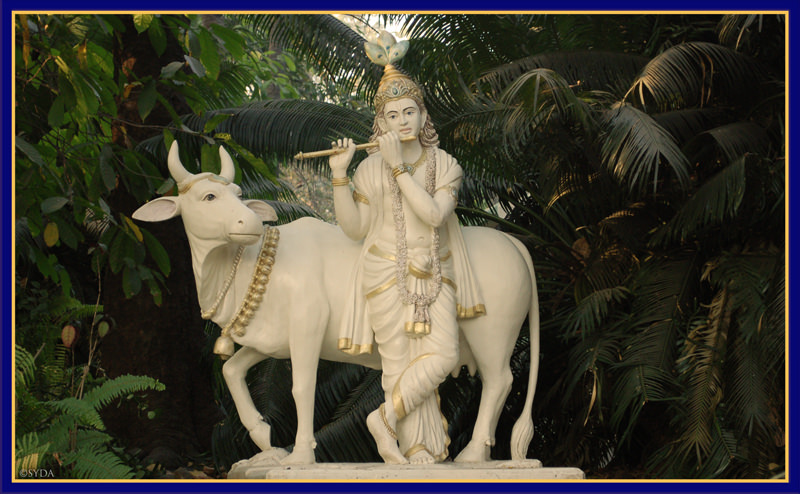Lord Krishna, Personification of Divine Love
by Shambhavi Christian


Lord Krishna is one of the avatars, or incarnations, of Lord Vishnu. He is revered as the bestower of divine knowledge. Many of Lord Krishna’s teachings are contained, for example, in Shri Bhagavad Gita, one of the most influential scriptural texts the world has ever known. Shri Bhagavad Gita is a cornerstone of humankind’s legacy of spiritual and moral wisdom.
The birth of Lord Krishna is known as Krishna Janmashtami. In the Indian lunar calendar, Krishna Janmashtami occurs on the eighth day of the waning moon during the month of Shravana. The night of Krishna Janmashtami, called Moharatri, is considered to be one of the three most auspicious nights of the year. Every minute of these three nights is auspicious, giving heightened power to the spiritual practices we perform during this time. In 2025, the date of Krishna Janmashtami is August 15.
The day after Lord Krishna’s birth is celebrated as Gopal Kala, also called Dahi Handi. This celebration is an homage to Lord Krishna’s childhood. There are many stories of the miracles and mischief that would take place in his presence when he was a child. In all of these stories, however, there are deeper lessons to glean. Lord Krishna’s apparent “mischief” always had a grander purpose; his exploits were a façade, a means by which he imparted to people the secrets of the universe or granted them moksha, liberation. Those who loved baby Krishna, those who were devoted to him, were in turn met with love—and this was Krishna’s love, which is the purest, most divine, most enchanting love, inexhaustible and unending in its magnitude.
The joyful festival of Dahi Handi highlights the stories of how baby Krishna loved to steal butter and curds from his mother’s pot, which she never managed to keep out of his reach. On Gopal Kala, people hang handi, earthen pots, filled with dahi, or yogurt, at a considerable height. Young men and boys form human pyramids to reach and break the pots, while the girls cheer them on and sing rousing songs about Lord Krishna.
Fast forward to when Lord Krishna, in his adult form, was teacher and guide to the mighty warrior Arjuna on the battlefield of Kurukshetra. In Shri Bhagavad Gita, Lord Krishna explains to Arjuna the purpose for his taking birth on this earth:
यदा यदा हि धर्मस्य ग्लानिर्भवति भारत ।
अभ्युत्थानमधर्मस्य तदात्मानं सृजाम्यहम् ॥
परित्राणाय साधूनां विनाशाय च दुष्कृताम् ।
धर्मसंस्थापनार्थाय सम्भवामि युगे युगे ॥
yadā yadā hi dharmasya glānirbhavati bhārata ।
abhyutthānamadharmasya tadātmānaṁ sṛjāmyaham ॥
paritrāṇāya sādhūnāṁ vināśāya ca duṣkṛitām ।
dharma-saṁsthāpanārthāya sambhavāmi yuge yuge ॥
O Arjuna, scion of the Bharata dynasty,
whenever dharma is weakened and adharma is on the rise, I manifest.1
For the protection of the good and the destruction of evildoers,
for the sake of establishing dharma, I am born in every age.2
Seekers through the ages have been captivated by Lord Krishna, by his teachings and the stories of his life. The sound of Lord Krishna’s flute has been the source of particular adoration. During Krishna’s own lifetime, the gopis, cowherders of Vrindavan were so enraptured by the melodious trills of his flute that whenever they heard its notes, they would drop whatever they were doing and follow its sound. The raslila, the dance of divine love, would ensue.
This love, magnetic in its potency, was not restricted to those who were around Lord Krishna in his physical form. Devotees of the Lord have, centuries on, felt this love stirring in their hearts and heard the music of his flute within their being. Inspired by such experiences, great writers, poets, singers, musicians, dancers, artists, storytellers, scholars, and saints have composed masterpieces in homage to Lord Krishna. People from all cultures and walks of life have experienced his divine presence and drawn inspiration and comfort from it.
On the Siddha Yoga path, we chant many names of God. However, there’s always something special about chanting in honor of Lord Krishna. I’ve noticed that as soon as people hear one of Lord Krishna’s names in a namasankirtana, a huge smile spreads over their faces. One of the Siddha Yoga namasankirtanas that extols Lord Krishna is Krishna Govinda. Its traditional melody is in the Bhairavi raga, which evokes the rasas of devotion and yearning for the Beloved. In this chant, which is most fitting for the celebration of Janmashtami, we sing in praise of the youthful Krishna:
Krishna Govinda, Govinda Gopala,
Krishna Murali Manohara Nandalala
O Lord Krishna, divine cowherd!
O Lord Krishna, protector of cows!
O delightful son of Nanda,
you captivate the heart with your flute!


2Shri Bhagavad Gita, 4.8 ed. Swami Kripananda, Jnaneshwar’s Gita: A Rendering of the Jnaneshwari (Albany, NY: SUNY Press, 1989), p. 48.


